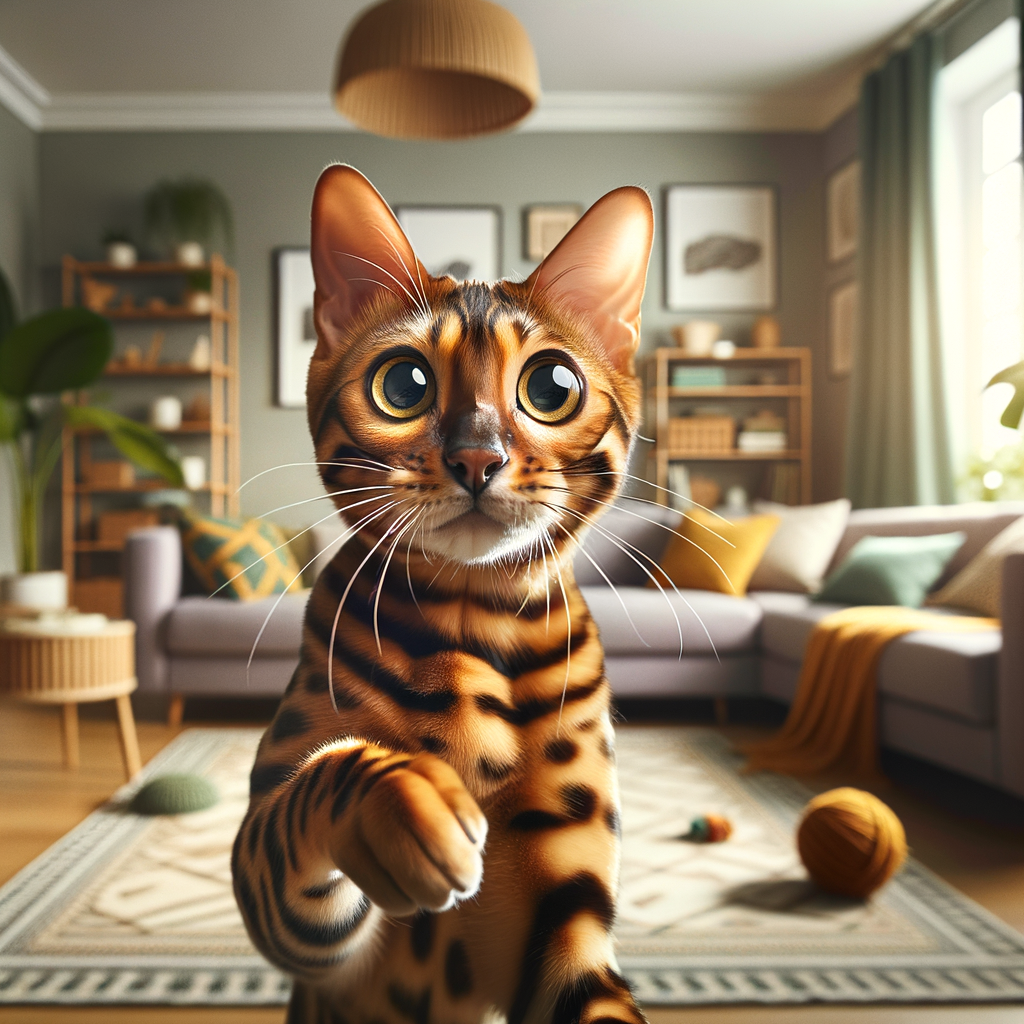
Introduction to Bengal Cat Genetics and Temperament
- Overview of Bengal cats: Bengal cats are a unique breed known for their striking appearance and playful nature. They have a wild look, thanks to their spotted or marbled coat, which resembles that of a leopard. Bengals are active, intelligent, and love to interact with their human families.
- Understanding Bengal cat genetics: They are a hybrid breed, created by crossing domestic cats with the Asian leopard cat. This mix gives them their distinctive coat patterns and energetic personality. Knowing their genetic background helps in understanding their behavior and health needs.
- Importance of temperament in Bengal cats: Their lively and curious nature makes them great pets, but they also need lots of stimulation and attention. Understanding their temperament can help owners provide a better environment for these active cats.
Bengal Cat Genetics: An In-depth Look
Genetic Influence on Bengal Cats
-
Role of genetics in Bengal cat behavior
Genetics play a big part in how Bengal cats act. For example, some Bengals are more playful and active because of their genes. These cats might love to climb and explore. Other Bengals may be calmer and enjoy lounging around. Understanding these behaviors can help you know what to expect from your Bengal cat.
-
Understanding genetic factors in Bengal cats
Genetic factors are like blueprints for Bengal cats. These blueprints decide their fur color, patterns, and even their health. Some Bengal cats have a spotted coat, while others have a marbled one. These patterns are passed down from their parents. Knowing about these genetic factors can help you choose the right Bengal cat for your home.
| Genetic Factor | Impact on Bengal Cats |
|---|---|
| Coat Color | Determines if the cat has a spotted or marbled coat |
| Behavior | Influences if the cat is playful or calm |
| Health | Affects the cat’s overall well-being |
Hereditary Traits in Bengal Cats
-
Common genetic traits in Bengal cats
Bengal cats are known for their unique coat patterns and colors. These traits are inherited from their wild ancestors, the Asian leopard cats. Common genetic traits include:
- Spotted or marbled coats: These patterns make Bengal cats look like little leopards.
- Glitter: Some Bengals have a shiny coat that sparkles in the light.
- Large, expressive eyes: Their eyes are usually green or gold, adding to their wild appearance.
-
How genetics influence Bengal cat characteristics
Genetics play a big role in shaping a Bengal cat’s looks and behavior. Here are some ways genetics influence their characteristics:
- Coat color and pattern: Specific genes determine whether a Bengal will have a spotted or marbled coat.
- Body structure: Bengal cats are usually muscular and athletic, traits inherited from their wild ancestors.
- Temperament: Genetics can also affect how playful or active a Bengal cat is. Some may be more curious and energetic, while others might be calmer.
| Trait | Description |
|---|---|
| Spotted or Marbled Coats | Unique patterns that resemble wild cats. |
| Glitter | A shiny coat that sparkles in the light. |
| Large, Expressive Eyes | Eyes are usually green or gold, adding to their wild look. |
| Muscular Body | Inherited from wild ancestors, making them athletic. |
| Playful Temperament | Some Bengals are very curious and energetic. |
Bengal Cat Temperament: What to Expect
Bengal Cat Behavior and Personality Traits
-
Understanding Bengal cat behavior
Bengal cats are known for their active and playful nature. They love to climb, jump, and explore their surroundings. This breed is also very curious and intelligent. Bengal cats often engage in interactive play and can even learn tricks. They are not your typical lap cats; they need lots of mental and physical stimulation.
-
Common Bengal cat personality traits
Bengal cats are affectionate but in their own unique way. They are very social and enjoy spending time with their human families. However, they can be quite vocal and may “talk” to you with a variety of sounds. Bengals are also very confident and can sometimes be a bit demanding when they want attention.
| Trait | Description |
|---|---|
| Active | Bengal cats are very energetic and need lots of playtime. |
| Curious | They love to explore and investigate their surroundings. |
| Intelligent | Bengals can learn tricks and enjoy interactive toys. |
| Vocal | They communicate with a variety of sounds and can be quite talkative. |
| Affectionate | While not typically lap cats, they enjoy being around their human family. |
Bengal Cat Nature: The Good and The Bad
-
Positive aspects of Bengal cat nature
Bengal cats are known for their playful and energetic nature. They love to climb, jump, and explore. This makes them very entertaining pets. Bengals are also very intelligent. They can learn tricks and enjoy interactive toys. Their social nature means they often get along well with other pets and children.
Another positive aspect is their affectionate behavior. Bengal cats often form strong bonds with their owners. They enjoy being around people and can be very loving. Their unique and beautiful coat patterns are also a big plus. Many people find their leopard-like spots and sleek fur very attractive.
-
Challenges with Bengal cat temperament
Despite their many good traits, Bengal cats can be challenging. Their high energy levels mean they need a lot of physical and mental stimulation. Without enough activity, they can become bored and may develop behavioral issues. This includes scratching furniture or being overly vocal.
Bengals can also be quite demanding. They need a lot of attention and can become anxious if left alone for long periods. Their intelligence, while a positive trait, can also lead to mischief. They might open doors or get into places they shouldn’t. Potential owners should be prepared for these challenges and ensure they can meet the needs of a Bengal cat.
Bengal Cat Breeding and Its Impact on Temperament
Role of Breeding in Shaping Bengal Cat Temperament
- How breeding influences Bengal cat temperament:
By selecting parent cats with desirable traits, breeders can influence the behavior and personality of the kittens. For instance, if the parent cats are friendly and sociable, their kittens are more likely to inherit these traits. This selective breeding helps ensure that Bengal cats are not only beautiful but also have a pleasant temperament.
- Considerations for Bengal cat breeding:
First, breeders must ensure that the parent cats are healthy and free from genetic disorders. This helps produce healthy kittens with fewer health issues. Second, the environment in which the kittens are raised is crucial. A nurturing and stimulating environment can positively impact their temperament. Lastly, socialization from a young age is essential. Kittens that are exposed to different people, animals, and experiences tend to be more well-adjusted and friendly.
Case Studies: Bengal Cat Genetics and Temperament
Case Study 1: Bengal Cat Temperament and Genetic Influence
-
Overview of the case study:
This case study examined the relationship between genetics and temperament in Bengal cats. Researchers observed a group of Bengal cats over a period of six months. They recorded behaviors, interactions, and responses to various stimuli. Genetic samples were also collected to identify any common genetic markers.
-
Key takeaways from the case study:
- Genetic Markers: The study found specific genetic markers that were linked to more social and playful behaviors in Bengal cats.
- Behavior Patterns: Cats with certain genetic traits were more likely to be friendly and less aggressive.
- Environmental Influence: While genetics played a significant role, the environment also impacted the temperament of the cats.
Case Study 2: Bengal Cat Breeding and Temperament
- Overview of the case study:This case study explores how breeding practices affect the temperament of Bengal cats. It examines different breeding methods and their impact on the cats’ behavior. The study includes data from various breeders and cat owners.
-
Key takeaways from the case study:
- Selective Breeding: Breeding for specific traits can lead to more predictable temperaments. For example, breeding calm cats together often results in calmer kittens.
- Genetic Diversity: Maintaining genetic diversity is crucial. It helps prevent health issues and supports balanced temperaments.
- Early Socialization: Kittens that are handled and socialized early tend to be friendlier and more adaptable.
- Environmental Factors: The environment where kittens are raised also plays a significant role. A calm, nurturing environment leads to well-adjusted cats.
| Breeding Practice | Impact on Temperament |
|---|---|
| Selective Breeding | More predictable and desirable traits |
| Genetic Diversity | Balanced temperament and fewer health issues |
| Early Socialization | Friendlier and more adaptable cats |
| Calm Environment | Well-adjusted and less anxious cats |
Understanding Bengal Cat Genetics and Temperament
-
Summary of Bengal cat genetics and temperament:
Bengal cats are a unique breed with a rich genetic background. They are a mix of domestic cats and the Asian leopard cat. This blend gives them their distinct look and playful nature. Bengals are known for their striking coat patterns and active behavior. Their genetics play a big role in their personality and health.
-
Final thoughts on Bengal cat behavior and personality traits:
Bengal cats are energetic and curious. They love to explore and play. They can be very affectionate but also need lots of attention. Understanding their genetics helps in knowing their needs and behaviors. Bengals can be a great addition to families who can match their energy and curiosity. They are not just pets but companions with unique traits.






